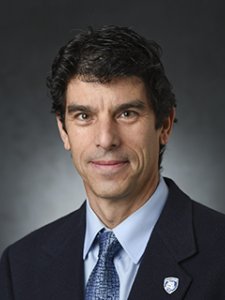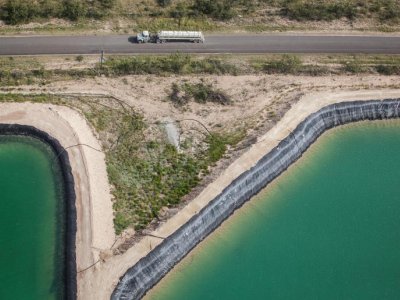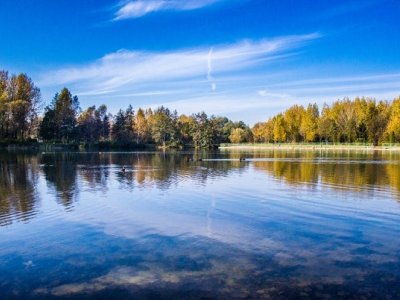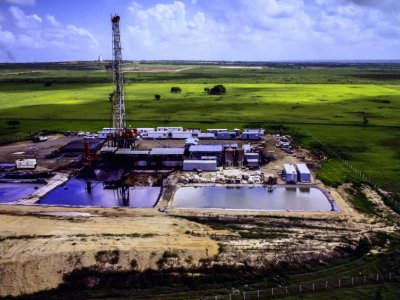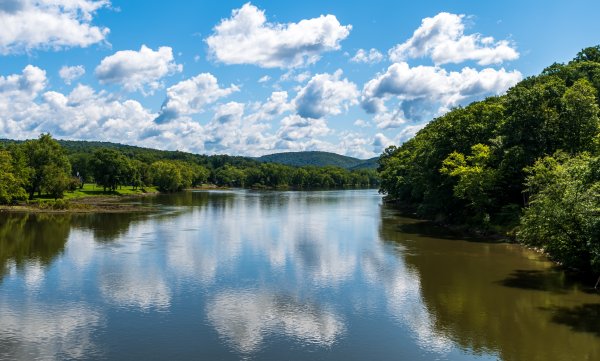
In 2009-2010, more than 50% of the Marcellus Shale wastewater generated in Pennsylvania was treated by centralized waste treatment plants (CWTs) and 42% of these CWTs had permission to discharge to surface water. The percentage of CWTs discharging to surface waters has dropped in recent years, but discharge of treated conventional oil and gas (O&G) wastewater effluent from CWTs has occurred for decades and still occurs in Western Pennsylvania. Many of the contaminants of concern in oil and gas wastewater are known to pass through these facilities despite treatment. The discharges contain high concentrations of barium, strontium, naturally occurring radioactive material (NORM), and trace metals.
Once discharged to surface water much of the strontium, barium, and NORM become associated with particulate matter in the receiving streams. Sedimentation of these particles leads to accumulation in sediments and porewaters. Indeed, sediment immediately downstream of one facility contained up to 200 times background radioactivity. This accumulation of toxic and radioactive elements in stream sediments could pose long-term environmental and health concerns by serving as a slow-release contaminant source. The accumulation of wastewater contaminants in well-laminated stream sediments provides the means to analyze and reconstruct historical industrial activities in the Allegheny River watershed. The objective of this project is to investigate the potential adverse impact associated with O&G wastewater disposal on sediment quality in Pennsylvania. This decades-long (and ongoing) management strategy could lead to elevated risks to aquatic life (e.g., macroinvertebrates, mussels, and fish), riparian environments (e.g., bioaccumulation in wetland environments), and human health (e.g., drinking water intake facilities) in areas downstream of the discharge both now and in the future during sediment remobilization. We hypothesize that these risks can be quantified using sediment cores as forensic tools that record discharges of O&G treated effluent over time, which should help guide future O&G wastewater management strategies.
We propose to collect sediment cores upstream of Lock 9 on the Allegheny River. This location is downstream of two CWTs (one each in Warren and Franklin, PA) where elevated activities of radium have been measured in sediments at the point of discharge. Combined, these facilities discharged over 400 million gallons of O&G wastewater to surface water since 1995. We hypothesize that major element chemistry (e.g., Cl, Na, Sr, Ba) and isotope ratios (e.g., 87Sr/86Sr and 228Ra/226Ra) from sediments may be able to identify the impact of O&G wastewater activities over time5, 6. Inadequate treatment of wastewater by CWTs can result in surface water discharge of radionuclides, metals, and organic constituents that could pose risks to aquatic and human health. Nevertheless, little is known about the potential accumulation of these contaminants in river and lake sediments and the risk they pose to human health and ecosystem services. Sediment cores will be age-dated, and used to measure major elements (Cl, Br, Sr, Ba) and isotopic ratios (87Sr/86Sr and 226Ra/228Ra) that may provide unique chemical signatures of O&G wastewater preserved in the sediment record.
Resulting Funding
- National Science Foundation, Chemical, Bioengineering, Environmental, and Transport Systems (ENG/CBET), Impact of Oil & Gas Wastewater Disposal on Lake and River Sediments, 2017, $330,000
Resulting Publications
- Burgos, W.D., Castillo Meza, L.^, Tasker, T.L.^, Geeza, T.J.^, Drohan, P.J., Liu, X., Landis, J., Blotevogel, J., McLaughlin, M.^, Borch, T., Reilly, R., & Warner, NR. Watershed-scale impacts from surface water discharge of oil & gas wastewater. Environmental Science and Technology (2017) http://pubs.acs.org/doi/abs/10.1021/acs.est.7b01696
Resulting Presentations
- Warner, N. R., Burgos, W., Drohan, P. & Borch, T. “Keynote: Historical Wastewater Management Recorded in River-Lake Sediment and Porewater Using Major Elements, 7Be, 210Pb, 87Sr/86Sr, and 226Ra/228Ra” Goldschmidt Conference, Yokohama, Japan. June 26, 2016-July 1, 2016.
- Warner, N. R., “Surface water and shallow groundwater impacts from oil and gas development”. Miami University, OH Department of Geology & Environmental Earth Science, Fall Seminar Series. November 11, 2016.
- Warner, N. R., Burgos, W., Drohan P., Geeza, T., & Castillo Meza, L. "River-lake sediment record of historical oil and gas wastewater disposal in western Pennsylvania" 252nd American Chemical Society National Meeting & Exposition, American Chemical Society, Philadelphia, PA. August 21-25, 2016.
- Warner, N. R., “Surface water and shallow groundwater impacts from oil and gas development”. Miami University, OH Department of Geology & Environmental Earth Science, Fall Seminar Series. November 11, 2016.
- Warner, N. R., “Impacts of treated oil and gas wastewater discharge on sediments of western Pennsylvania”. Shale Network Workshop 2017, May 18-19, 2017.
- Warner, NR, Heinz Foundation “Road and Surface Water Spreading of Oil and Gas Wastewater.” Informational meeting and discussion at the Heinz Endowment. Pittsburgh, PA. (January 9, 2017).
- Burgos, W. D., Joint USACE/USEPA Water Quality Workshop, US Army Corps and EPA, Cincinnati, OH, "Record of shale gas wastewater disposal in Conemaugh River Lake sediments," Invited. (December 6, 2016). National.
- Tasker, T., Grant, A., Geeza, T., Warner, N. R., Burgos, W. D., 25th American Chemical Society National Meeting, American Chemical Society, Philadelphia, PA, "Geochemistry and metal release of Marcellus Shale and surrounding rock formations," Accepted. (August 22, 2016). International.
- Burgos, W. D., Korea Maritime University, Busan, South Korea, "Impact of shale gas wastewater disposal on lake sediments," Invited. (May 30, 2016). International.
- Burgos, W. D., Hanyang University, Seoul, South Korea, "Impact of shale gas wastewater disposal on lake sediments," Invited. (May 24, 2016). International.
-
Burgos, W. D., Seoul National University, Seoul, South Korea, "Impact of shale gas wastewater disposal on lake sediments," Invited. (May 23, 2016). International.
-
Burgos, W. D., Colorado State University, Fort Collins, Colorado, "Record of shale gas wastewater disposal in Conemaugh River Lake sediments," Invited. (January 30, 2017). National.
-
Burgos, W. D., University of British Columbia, Vancouver, Canada, "Record of shale gas wastewater disposal in Conemaugh River Lake sediments," Invited. (March 23, 2017). International.
-
Puhr, J.*, Van Sice, K^, and Warner, NR. “Radium Fate and Transport”. College of Engineering Research Initiative (CERI) Fall Poster Symposium. University Park, PA. December 7, 2016.
-
Meza, Luis Castillo ^ “Impact of Shale Wastewater Disposal on Conemaugh River Lake Sediments”, Shale Network Workshop, State College, PA May 20, 2016.
-
Van Sice, K.^ and Warner, NR. Fate and transport of radium from brine wastewater treatment discharges in Western Pennsylvania. 254th American Chemical Society National Meeting & Exposition, American Chemical Society, Washington, DC. August 20-24, 2017.
-
Van Sice, K.^ and Warner, NR. Elevated radium activities in sediments from oil and gas wastewater disposal. Environmental Chemistry and Microbiology Student Symposium, University Park, PA. April 22, 2017.
-
Van Sice, K., Radium activities in sediments from oil and gas wastewater disposal. Kappe Seminar, University Park, PA. April 1, 2017.
-
Van Sice, K.^ and Warner, NR. Radium fate following oil and gas wastewater disposal to surface waters. Society for Freshwater Science Annual Meeting Raleigh, NC June 4-8, 2017.



